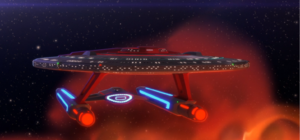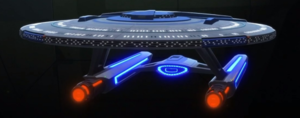California class
More actions
The California-class utility cruiser is a ubiquitous and utilitarian starship class that has been a fixture of the interior of Federation space since the late 2360s, performing important but quotidian missions ranging from minor scientific surveys, to medical and engineering support missions, and routine transport assignments. These ships blend into the background but are essential to the work of Starfleet, and come in several variants tailored to specific mission profiles. Not considered capital ships, California-class vessels are a stepping stone for officers who want to move on to bigger and better commands but first have to put in their time doing the bread-and-butter missions that are essential to keeping the Federation running.
Science and Exploration
Often assigned to archaeological and scientific support missions to follow up on discoveries made by more important vessels, California-class ships are equipped with sizable science departments, rivaling purpose-built science ships for all but the most intensive surveys. These starships are also useful for deploying and retrieving remote observation probes and other such devices. Their large cargo bays make them adept at resupplying scientific outposts, which is another way that many of these vessels contribute directly to the Federation’s scientific endeavors.
California-class ships are used for follow-up exploratory missions after the large explorers have passed through a region, usually to fill in star charts and perform slower, more detailed examinations of a region of space, but they rarely venture far from Federation territory on their own.
Diplomacy
This class of starship was specifically designed to conduct a wide variety of second-contact missions, including performing engineering and scientific support roles and otherwise helping a new culture integrate into the Federation. Because of this, these ships have a larger-than-average number of shuttles for their size and can carry vast amounts of cargo. When first contact is done, a California-class ship will be sent in to set up communications equipment and other facilities to make it easier for a new world to stay in touch with the rest of the galaxy.
Though purpose-built couriers and larger explorers are used for high-profile diplomatic missions, California-class ships perform many low-priority missions for the Federation Diplomatic Corps, transporting dignitaries to and from their destinations and assisting alien cultures directly with good-will humanitarian projects.
Engineering
The California-class is instantly recognizable as sharing a lineage with the Galaxy-class explorer, though she has about half the internal volume. With systems designed through lessons learned on the other cousins of the Galaxy, the California has a round primary hull with many windows, along with long phaser arrays on the ventral and dorsal surface. This twelve-deck saucer contains the majority of the ship’s systems, as well as crew quarters and cargo facilities. A superstructure on the dorsal surface contains the bridge, and an extension under the ventral surface contains the ship’s two impulse engines.
Underslung from the primary hull are the warp nacelles and secondary hull, with the two boxy nacelles connecting directly to the primary hull with two long struts and the secondary hull, in turn, connecting to the nacelles with shorter struts.
The nine-deck secondary hull contains the main deflector, as well as main engineering, with the warp core running the height of this module. Access to this area is provided by standard turbolifts and Jefferies tubes. The warp core and nacelles are oversized for a ship of her size to allow her to tow other ships at warp. To facilitate deep-space towing, the California-class has a powerful aft tractor beam emitter.
Small craft support is provided by three shuttle bays: two on the aft corners of the primary hull, and a third in the secondary hull. These bays each house five to six shuttles, and provide for extensive small craft operations. This is especially useful for large-scale engineering projects which may require constant arrivals and departures that would be difficult to accommodate with a single bay. California-class ships are equipped with a captain’s yacht, docked in a dedicated bay under the saucer.
Warp power is provided by a class-six warp core, though it has been enhanced with some features also found aboard the Galaxy-class’s class-seven system, resulting in modest top speeds, but the ability to expand its warp field significantly to accomplish warp towing of other ships. Generally speaking and by definition of their role as a second-string ship following up on the discoveries of more important vessels, California-class ships don’t need to get anywhere in a hurry. The maximum speed of this class is warp 8; while the warp core can push the ship faster, it would result in severe structural damage to the ship.
Tactical
California-class starships are not meant for combat; they are generally expected to retreat in the face of superior foes and can only handle only lightly-armed opponents, such as light raiders or other small threats. The ship’s primary defenses are a set of self-repairing shields, though she is also equipped with three Type-X phaser arrays, two 270° arrays on the dorsal and ventral surface of the saucer, and a third aft array on the dorsal saucer, which provides adequate phaser coverage over most arcs. This class also has two photon torpedo launchers, located in protrusions above the saucer section which also contain the torpedo magazines.
In a fleet engagement, California-class ships would perform support functions such as towing damaged vessels away from the combat zone, retrieving escape pods, and providing sensor data to combat-ready vessels. Their lack of serious offensive capabilities is often what keeps them safe in these situations—they're simply not a high enough target priority to draw much enemy fire.
Shipboard Life

California-class ships serve an important function in Starfleet, but they are second-rate vessels. As utility cruisers, they get the missions that aren’t important enough for more advanced ships, and so their crews tend to be more junior than those posted to frontline explorers. A California-class ship can often be a stepping stone to more interesting and important assignments, so they’re usually transitory stops for captains and crew alike. Still, California-class crews recognize their importance to the fleet and take great pride in their ships, even if they are no longer particularly modern.
Relatively uniquely, California-class ships accommodate junior personnel (ranking ensign and lower) in so-called residential hallways in the lower three decks of the saucer section, which are wide corridors that also contain bunks and lavatory facilities. This is a necessity for this class, given that a significant portion of the internal volume is taken up by cargo holds and other equipment necessary to perform its support missions. Officers ranked Lieutenant and higher are given their own quarters, however. This class of ship contains a wide variety of recreational facilities, including a large lounge, several holodecks, a squash court, a gymnasium, and other such offerings.
Like the Galaxy, Nebula, Luna, and Odyssey classes, most California-class ships have Cetacean Operations departments which can accommodate a variety of aquatic species.
Variants
Though all of the members of this class are generally capable of performing all low-intensity utility missions, the California-class is produced in several variants tailored to specific mission profiles. Each variant has a unique set of hull markings to help them stand out in dock and to promote a sense of esprit de corps among their crews.
The engineering support variant has a larger concentration of engineering personnel, as well as enhanced structural integrity and tractor-beam systems, which make it well-suited for towing missions. These vessels have gold paint.

The scientific support variant is equipped with additional science labs and an extensive probe magazine, as well as more scientific personnel. These vessels can handle long-duration surveys and other expeditions within Federation space. These vessels have blue paint.
The command support variant has diplomatic quarters and accommodations for flag officers, as it is normally used to transport dignitaries within the Federation. This is the least common variant and has red paint.
The medical support variant has hospital facilities to accommodate up to 200 patients, in place of a lot of their cargo facilities. They also embark specialized ambulance shuttles and can deploy field hospitals; they operate in concert with Olympic-class hospital ships for large emergencies and can handle smaller issues on their own. Their hulls are painted white with blue accents.
Class History
While individually, the precursor classes to the Galaxy and Nebula-classes developed in the 2340s and 2350s each had their strengths, their capabilities varied widely and they were seen as a waste on general utility duties, and most of them were too small to carry the supplies necessary for large humanitarian and engineering projects anyway. In addition, the Miranda-class vessels that were being used in these roles were already antiques in the 2330s let alone the 2360s, so it was decided to develop a new, modern starship to be produced in large numbers and handle day-to-day missions across the Federation.
Taking design cues from the Galaxy-class and Miranda-class, the California-class was designed relatively quickly, going from order to design to prototyping between 2363 and 2367. The California herself was commissioned in early 2368, the year following the Battle of Wolf 359. While changes to Federation starship building in response to the Borg crisis resulted in the immediate cancellation of the California’s four smaller cousins, the new, more combat-orientated designs that resulted from this decision made an even greater demand for the California, as these new ships would be needed for frontline service.
Thus, the California-class became one of the most widely-produced vessels in Starfleet, with several dozen being produced each year from 2367 through the mid-2380s. Production slowed following the introduction of the larger and more advanced Parliament-class utility cruiser in the 2380s, but there are no signs that Starfleet will stop building these vessels any time soon.
In Play
- As portrayed in Star Trek: Lower Decks, this class of ship is ubiquitous and utilitarian; they handle all of the minor, tedious missions necessary to keep the Federation running, ranging from setting up labs to delivering cargo to repairing subspace relays. They're not meant to go out exploring on their own.
- California-class ships never venture much farther than a week or so from a port, as they're constantly picking up supplies and equipment to transport on their missions.
- This is a very junior posting for both captains and crew, and is a very typical first assignment for all but the very best and brightest within Starfleet.
- California-class ships are geared for support roles, not for tactical roles, black ops, or other cloak-and-dagger activities.
- As a midshipman, this will be the first starship class that you gain access to. It is an excellent starting platform, because you will be able to participate in fleet events and have a whole crew of your own, while you work up to lieutenant commander to gain access to a wider variety of ships.
